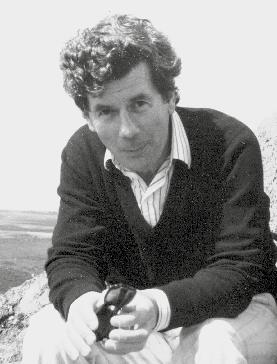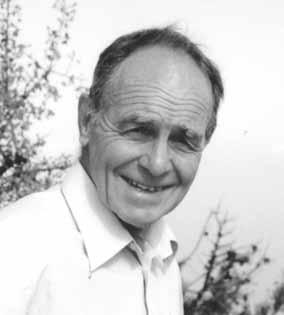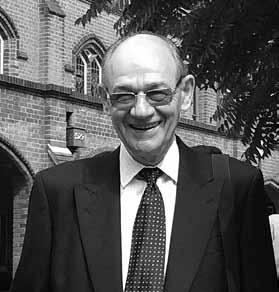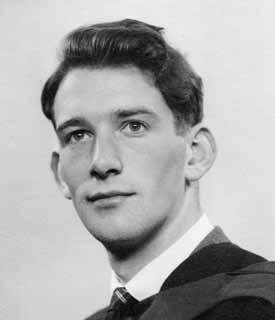
12 minute read
Obituaries
Brian drake (1944) Laurence Drake (1981) writes:
Father won a scholarship to The Perse, thus costing his father the princely sum of £1 per term. Academically he did well, earning school prizes with monotonous regularity every year in maths and sciences. During the war The Perse was one of the few Cambridge buildings to be bombed, and he recalled arriving one morning when the Headmaster, unaffectionately nicknamed “Gob”, told them, “No school today, boys”, whilst behind him the smoking remnants of the school hall dripped with water from the fire hoses.
Bearing in mind how few bombs fell on Cambridge, it was an extraordinary coincidence that not only was the school hit, but so also was Gob’s house on Barrow Road … so he moved to Huntingdon Road – where he was promptly bombed out again! These events inspired him in his retirement to research an article on the Bombing of Cambridge, which is now in the archives of the London Imperial War Museum.
He won a scholarship to St John’s College, Cambridge in 1944 to read Natural Sciences, thereby starting a family tradition there with his sons Laurence (1981) and Marcus (1984) reading Medicine, and grandson William (2015) studying Physics. After national service, in 1948 he switched to Preclinical Medicine. These students were allocated to the same body for dissection: Swallow, Swift, Swan, Drake and Pond!
At Cambridge he foolishly risked everything in night climbing over the colleges. He marvelled at the nocturnal beauty and peace of those medieval courts viewed from the roofs. He managed to jump from the College gardens and climb over the Bridge of Sighs.
He and three others, in peril from the feared University Proctor, accessed the roof of the College’s Gatehouse tower, and hoisted a toilet to the top of the flagpole! The Cambridge Daily News published a photo and the rhyme they’d been urgently sent: “Come and see what you never did see – a WC where the flag ought to be!”
In 1951 he defected to Oxford to study Clinical Medicine at Balliol and the Radcliffe Infirmary, and at 31, he became Histon’s GP, on call day and night, until retirement in 1990. He usually visited patients by bicycle, which they loved. He was extremely popular and a kind, respected doctor. In the appalling winter of 1963 he attempted to skate from Cambridge to Ely. At Clayhithe, the ice gave way under the bridge near a sewage outlet. A photo appeared in the Cambridge News under a heading of “A ducking for Dr Drake”.
Retirement began in 1990, with his partner Janet (he had divorced from his Danish wife in 1974). A Histon road was named in his honour: Drake Way. He had tremendous talent in playing the piano and organ, passing the LRAM and LRCM exams. He gave recitals – even sometimes after morning surgeries to drug reps, if they were attractive enough! With a violinist friend (or son Laurence) he performed successfully in the Cambridge Competitive Music Festival.
He learnt the organ in King’s College Chapel and also St John’s, filling these wonderful buildings with fabulous music, usually Bach. Occasionally whilst practising on the Histon organ he’d leave a notice on his surgery door: ‘If you need a doctor urgently please rattle the church vestry door!’ In 1988 he gave an impressive recital on King’s Chapel organ.
He was a kind, good humoured, gentle and generous man and father. He had considerable talent, but selfdoubt and modesty would always prevent any hint of arrogance.
At the age of 90 he was still cycling into Cambridge, having been blessed with excellent health. Over the last year, cerebrovascular disease necessitated spending his last months in a nursing home, where he showed gratitude and politeness throughout. He passed away peacefully and before he’d lost much dignity or suffered unduly. There is a great deal to be thankful for in all that.

Benjamin moore (1950) John Harris (1950) writes:
Ben Moore died last year aged 86, after an undiagnosed debilitating illness. We were contemporaries throughout our school days, and in fact we must have met even before school, as our fathers were founding members of the Dunn Nutritional Laboratory, and our families firm friends. I think it would be fair to say that already at school Ben showed that adventurous spirit that shaped his
later life. He was usually the one to suggest a new, daring escapade. A keen sportsman (perhaps rugby above all), he became captain of most of what were then referred to as “minor sports” – tennis, fives (in that unique court at the old Gonville Place site) – and boxing too, I think. I also have to thank him for introducing me to the pleasures of rowing on the Cam with the now defunct Cambridge Scouts Boat Club. Though not an outstanding academic he won an Exhibition to Christ’s. But before going up he did national service. During Officer training he fell 90 feet while climbing Tryfan in North Wales. In 1952 he was in Korea, where, aged 20, he was severely injured when leading a patrol in the demilitarised zone between South and North. At Christ’s he read geology and rowed bow in the College eight. Then after several years prospecting for oil in Canada and Brazil (which he later wrote up in Alberta to the Amazon), he surprised us all by retraining as a doctor, all paid for from his earnings in geology. He went on to a very successful career, becoming a Fellow of the Royal College of Obstetrics and Gynaecology and Consultant in Hereford. Before that, while working in Birmingham, he helped establish the country’s first menopause clinic. This work led to the award of the Cambridge MD. Both before and after retirement from the NHS he worked extensively overseas, including Tanzania, Zimbabwe, Cyprus, Saudi Arabia and more. He is survived by his wife Veronica (who I have to thank for much of the detail here), four children and five grandchildren.
It was a pleasure to meet him and a few other contemporaries several times in the last ten years or so, thanks to the initiative of another contemporary, the late Richard Dent (1950). Although physically impaired Ben’s spirit and great sense of humour were as robust as ever. management to return to programme making, thought well of him.
The two met and soon were talking about the crucial additional outside funding needed for a major series. Attenborough had contacts at Warner Bros and Mick followed them up – successfully. Over the next three years, he negotiated the funding, staffing and planning of Life on Earth, which was broadcast in 1979, as the first of the BBC’s blockbuster natural history series fronted by Attenborough and seen all over the world.
In 1977 Mick launched Wildlife on One, which ran for 28 years, as well as Badger Watch, the first show to use infrared cameras to show how animals live in the wild. By the time Mick resigned in 1978, the Natural History Unit was well under way to becoming the internationally renowned production centre it is now.
Mick moved to the US, partly to set up a US version of Wildlife on One, and partly to be with Barbara Benedek, a New York researcher for the BBC whom he had met while she was on secondment in London, and whom he was to marry in 1986.
In 1981, Mick returned to the BBC and in 1984 took over as Head of BBC Science Features, spending five years managing Tomorrow’s World, Horizon, QED and Your Life in Their Hands. In 1989, he went back to producing programmes. Among numerous other projects, he thoroughly enjoyed making segments for Gardeners’ World and Countryfile.
In 1996, Mick and Barbara bought a house in France, where Mick spent his time working on the property, watching birds and gardening. For the next 12 years he divided his time between France and the UK. He was diagnosed with dementia in 2008.
Mick passed away on 1 September 2018 and is survived by Barbara; and by Nori, the daughter from his first marriage, and two grandsons.

michael George Rhodes (1953) Peter Goodchild writes:
Mick (as he was known throughout his career) was born in Wye, Kent on 6 August 1935, to Frederick and Norah (née Collier) Rhodes. After WW2, the family settled near Cambridge. Mick joined The Perse, where he excelled in cross-country, rugby and sailing, the last of which became an enduring passion. After national service with the army in Germany and in Kenya during the Mau Mau uprising, he studied Zoology at Bangor University.
He was tempted away from PhD studies in 1964, sailing to Greenland and Baffin Island on a 60-year-old pilot cutter with the explorer Bill Tilman. Mick made a film about their journey, which he used as a passport to a job in the BBC Radio science department. One of his programmes there, Mr Blake, on the treatment of schizophrenia, won a Prix Italia and, in 1968, he was offered a job on Horizon.
Over the next three years Mick produced films on everything from rheumatism to rail crashes but soon made his first natural history film, The Wood (1971), about Wytham Woods. This led Mick to The Making of a Natural History Film (1972), about a group of scientist-filmmakers at Oxford Scientific Films. With great natural history filming and a surprisingly dramatic storyline, this modest film won not only a BAFTA and a Prix Italia, but an Emmy as well.
In autumn 1972, Mick arrived in Bristol to take over as head of the BBC’s Natural History Unit. The staff were sceptical of Mick and his limited natural history filming experience, but David Attenborough, who was just standing down from the BBC’s senior This is an abridged version of the obituary published in The Guardian, and is reproduced here with kind permission of Peter Goodchild and Barbara Rhodes.
Hugh Thomas (1954) Luke Lordon writes:
Hugh was born in Salisbury in 1936 but in 1938 the family left for Africa and Hugh didn’t return ‘home’ until he started at The Perse in 1947. With his family still in Nairobi, The Perse became very much a second home for Hugh and his time there clearly made a huge impression on him. He was proud to have been a prefect, head of his boarding house, vice-captain of the hockey team and earn cricket colours. Recalling intricate details, he loved to regale his family with tales of his school days. The Perse lifestyle clearly suited his personality and made a significant contribution to his personal development and the disciplined approach he took to life long after he left school in 1954.
After The Perse Hugh undertook national service with the Navy and during a training exercise met Patricia who was serving with the WRNS. He took articles with Moore Stephens Chartered Accountants and married Patricia in September 1961, continuing his Royal Naval Service as a Reserve for a further 10 years. He was promoted to the rank of Lieutenant and only resigned in 1970 when work and family commitments prevented him fulfilling his regular training duties.
Hugh continued to play hockey and cricket regularly. A weekend hockey match took him to Oxted in Surrey where he and Patricia later settled to bring up their family. Hugh began working as a qualified chartered accountant at Allan Charlesworth & Co in 1964, just a year before Sarah, his first daughter, was born. By 1969, soon after his second daughter Anna was born, he had already made it to the ranks of Partner. Hugh remained with the same firm, which merged to become Hays Allan, until his retirement in 1996.
Hugh had never been one for idleness, and after ‘retiring’ took on consultancy work, continuing even after a cancer diagnosis. Despite this ongoing determination to keep working Hugh continued to spend much of his spare time with his five grandchildren, for whom he was a trusted and much-loved role model. Retirement also gave Hugh the chance to indulge his passion for cricket. He got his long-awaited Membership of the MCC in 2008 and attended matches at Lord’s with friends whenever he could.
If there was a theme to Hugh’s life it would surely be that he was liked and respected wherever he went. He had an easy friendly way about him, and a genuine interest in others. He was witty, intelligent and a good conversationalist.
Hugh sadly lost his long-fought battle with cancer on Christmas Day 2018. His ashes were scattered by his family at The Harris Memorial Garden at Lord’s cricket ground.


derek Sederman (1956) Andy Sederman writes:
Derek Sederman was a pupil at The Perse School from 1945–1956 (including four years in the Perse Preparatory School) – he particularly enjoyed mathematics, no doubt encouraged by the head of maths there – his father, Vic Sederman. After leaving The Perse he obtained his teaching diploma from Loughborough Teacher Training College.
Derek spent all of his working life as head of PE at Abbotsholme School where he was appointed in 1960 and remained until his retirement in 1998. He left a very significant mark there taking on roles including Riversholme housemaster and head of Outdoor Education, leading many skiing and mountaineering trips and overseeing the design and building of Reddie Hall sports complex. He remained very much involved with Abbotsholme School after retirement, being on the school council until 2018.
Away from school, Derek had a very important role in the development of youth cricket in England. He was passionate about cricket and was instrumental in the formation and development of the England Under 19 National Cricket Team (now called the Young Lions) in the 1970s, ’80s, and, ’90s. He was Chairman of Selectors for England Under 19 for over 20 years (1976–1997) and chaired the National Cricket Junior and Youth Committee over the same period. He was on the County Cricket Club Committee of both Staffordshire (1973–1998) and Derbyshire (1999–2006).
Derek had a number of other interests to which he devoted much time. In particular, he loved music and was a founder member of the Abbotsholme Arts Society and was on the committee since its inception in 1968. Derek loved the great outdoors and especially loved visiting Golan in North Wales and Saas Fee – the “Pearl of the Alps”.
Derek died peacefully in Royal Stoke University Hospital on 1 November after a short illness. He is survived by his wife, Elizabeth, and their three children and six grandchildren.









